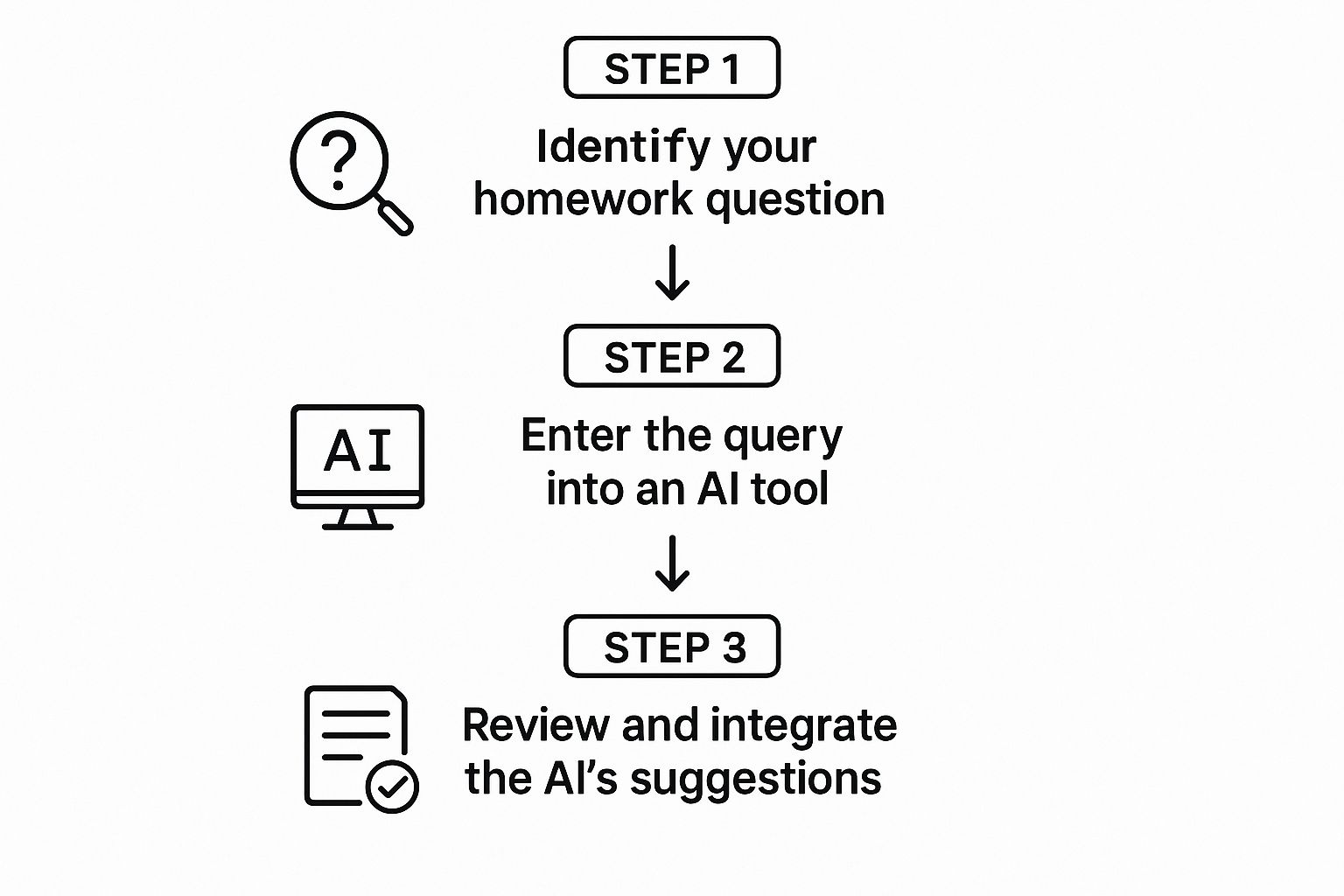Why AI Homework Help Is Changing Everything For Students
Forget those all-nighters fueled by caffeine and the creeping dread of deadlines. The way students tackle homework is changing, and AI homework help is leading the charge. This isn’t about finding shortcuts or dodging the work; it's about working smarter, not harder, and using AI as a personalized study buddy. Imagine having a super-patient tutor available around the clock, ready to walk you through any tricky concept.
This shift is happening thanks to tools like TextSpell's AI Homework Helper, designed to help students truly understand the material, not just get the right answer. I’ve talked to a bunch of students who use AI for homework, and they all say the same thing: it helps them actually learn, not just passively absorb information. They're asking “why” and “how,” not just “what’s the answer?”
For example, picture this: you’re stuck on a calculus problem. Instead of throwing your textbook across the room, you can use AI to break down the problem step by step, pinpointing exactly where you’re getting tripped up. This laser focus helps you target your weak spots, build confidence, and finally conquer that problem. It's not about replacing good old-fashioned textbooks and teachers; it's about adding a layer of personalized support.
This growing trend isn't a surprise. AI in education is exploding. In fact, the market for AI in education is expected to hit about $7.05 billion by 2025, up from $5.18 billion in 2024. This shows just how much demand there is for AI-powered learning. Learn more about the AI education market. More and more students are realizing that AI is a powerful learning tool, moving past worries about "cheating" and embracing a future where technology boosts their skills, not replaces them.
This shift is also a game-changer for different learning styles. Visual learners can use AI to create diagrams and mind maps. If you’re an auditory learner, you can have concepts explained out loud. Hands-on learners can use AI to create interactive practice problems. This ability to personalize learning is what makes AI homework help so revolutionary for students of all backgrounds and learning preferences.

Getting Your AI Study System Up And Running
Starting with AI homework help isn't about some magic app that spits out straight A's. It's more like setting up a really productive study space. Think about your desk – you want everything you need within reach, right? Minimal distractions. Same idea applies to your digital workspace when using AI tools like TextSpell.
This infographic helps visualize how AI fits into your homework flow:

Notice how you're still the one in charge. You identify the questions, you guide the AI, and you connect its suggestions to what you’re learning. It's an active partnership, not a shortcut.
Preparing Your Materials And Calibrating Your Expectations
Before you even open your laptop, gather your stuff. Textbooks, notes, anything related to the assignment. Just like you'd grab your calculator for math, having your resources ready makes your AI sessions way more efficient. And listen, don't expect the AI to do all the work. Think of it as a study buddy, there to help you learn, not just give you answers.
Setting Up TextSpell And Other AI Tools
When you first fire up TextSpell’s AI Homework Helper, take a few minutes to explore. Try different questions, see how it responds to different phrasing. It's like meeting a new tutor – you want to understand their style so you can get the most out of working together.
Creating A Productive Routine That Enhances Your Learning
Don't ditch your current study methods. Weave AI assistance into them. For example, if you usually solve math problems by hand first, keep doing that! Then use the AI to check your work or explore different approaches. This keeps you actively involved in the learning process while getting that extra boost. Remember, real understanding takes time and effort. AI can definitely help you get there faster, but it's not a magic bullet.
To help you get organized, I've put together a handy checklist:
This table outlines essential steps and considerations for setting up AI homework assistance for different subjects.
| Setup Element | Math/Science | Writing | General Tips |
|---|---|---|---|
| Gather Materials | Textbooks, problem sets, notes, calculator | Assignment guidelines, research articles, drafts | All relevant materials organized and accessible |
| Define the Task | Specific problems to solve, concepts to understand | Essay topic, research question, target audience | Clearly articulate the goal of the AI session |
| Framing Questions | Precise and focused on the specific difficulty | Open-ended questions to explore ideas, refine arguments | Experiment with different question types and phrasing |
| Integrating AI | Use AI to check work, explore alternative solutions, understand complex concepts | Use AI to brainstorm, outline, refine writing, check for plagiarism | Use AI to supplement, not replace, your own efforts |
| Review and Refine | Critically evaluate AI-generated solutions, ensure understanding | Review and edit AI-generated text, maintain your own voice and style | Always double-check AI-generated content for accuracy and completeness |
This checklist highlights how the same AI tool can be applied differently depending on the subject. While the core principles remain the same – preparation, clear goals, active engagement – tailoring your approach will yield the best results. Remember, it's about using AI to enhance your learning process, not the other way around.
Conquering Math And Science With Your AI Learning Partner
Math and science homework can be a real headache. But honestly, using AI homework help can totally change the game. I've seen students go from dreading these subjects to actually enjoying the learning process, tackling everything from tricky algebra problems to complicated chemical equations with way more confidence. The secret? Knowing how to use these AI tools the right way.
Asking The Right Questions And Breaking Down Complex Problems
One of the best ways to use AI is to break down those massive problems into smaller, bite-sized pieces. Instead of just asking for the answer, get the AI to explain the why behind it. For example, instead of "Solve this integral," try asking "Explain the steps for integrating this function." This way, you're not just getting the solution, you're actually understanding the logic, which is so much more helpful for learning the material.
Additionally, check out this screenshot from TextSpell’s website. It shows how their AI Homework Helper breaks down a math problem:

See how the AI lays out each step? This visual breakdown is a lifesaver, especially for visual learners, and makes complex problems seem much less scary. Want to learn more about TextSpell? Discover TextSpell’s Math AI Solver.
Verifying Solutions And Building True Understanding
AI is a fantastic tool, but it's not perfect. Always double-check your solutions, particularly with those tougher calculations. This isn't about distrusting the AI, it's about building solid study habits. Think of AI as a study buddy, not a replacement for your own brainpower.
It's also interesting to note that AI in education is booming. The global AI market is predicted to hit $244 billion by 2025, with the U.S. spending almost $74 billion this year alone. That's huge! It just shows the potential of AI in different fields, especially education. Discover more insights into the growth of AI. Learning to use these tools effectively now is definitely a smart move.
Generating Practice And Preparing For Exams
Don't forget about using AI for practice problems and exam prep! Ask it to create problems similar to the ones giving you trouble. This targeted practice helps you nail down those key concepts. You can even use AI to clarify confusing parts of your textbook or lecture notes. This personalized study approach can make a real difference in how you absorb information and perform on tests. The end goal isn't just about getting the right answer, it's about building real understanding and problem-solving skills that will help you throughout your academic journey.
Turning Writing Struggles Into Strength With AI Assistance
Writing assignments. Two words that can trigger a wave of anxiety for many students. But what if I told you they don't have to be so stressful? More and more, students are finding that artificial intelligence homework help can be a game-changer. Think of it as a secret weapon for overcoming writer's block, building stronger arguments, and polishing your writing without sacrificing your authentic voice. I'm going to walk you through how AI tools can become your trusted partners throughout your writing journey, from that initial brainstorming session all the way to those final edits.
Brainstorming and Idea Generation
We've all been there. Staring at a blank page, feeling utterly lost. AI can be your creative jumpstart. By simply entering a few keywords or a short description of your assignment, AI tools can generate a bunch of potential essay topics, research angles, or even creative writing prompts. It’s like having a brainstorming buddy, bouncing ideas around and exploring different avenues before you settle on the perfect one.
For example, let’s say you have to write about the impact of social media. You could use an AI tool to generate related topics like the influence of online personalities, the way misinformation spreads, or the effects of social media on mental health. This helps you narrow down your focus and find something that truly grabs your interest. TextSpell's Essay Writer can be a real help here.
Refining Arguments and Improving Sentence Flow
AI isn’t just about generating ideas; it’s also a powerful tool for making your arguments rock solid. By analyzing your writing, AI can pinpoint weaknesses in your logic, suggest supporting evidence, and even help you articulate your ideas more clearly. It’s like having a second pair of eyes providing valuable feedback you might have missed on your own.
And there's more! AI can significantly enhance the overall flow and readability of your writing. It can suggest different word choices, flag repetitive phrases, and even offer suggestions for restructuring your sentences, resulting in more polished and engaging prose.
Catching Grammar Errors and Expanding Vocabulary
Even the most seasoned writers make mistakes. It happens. AI is fantastic for catching those sneaky grammar and spelling errors that we all tend to overlook, especially when we've been staring at a screen for too long. It can also expand your vocabulary by suggesting alternative words that fit the context of your writing, helping your language sound more natural and sophisticated.
Let’s talk about visuals. If you're aiming for a professional look for your academic profiles, check out some of the AI tools available for generating profile pictures, like the ones discussed in this article about AI photo generators. Just remember, while AI is a fantastic tool, it’s crucial to maintain your own unique voice and style. It’s a collaborative partner, there to help refine your writing, not replace it.
Now, let's take a look at how you can specifically apply AI assistance to different writing assignments. The table below outlines several writing tasks and the strategies you can employ to make the most of AI's capabilities.
Writing Tasks and AI Assistance Strategies
| Assignment Type | AI Assistance Strategy | Student Role | Expected Outcome |
|---|---|---|---|
| Essay | Brainstorming ideas, refining arguments, improving sentence flow | Guides the AI, reviews suggestions, makes final decisions | A well-structured, logically sound, and engaging essay |
| Research Paper | Generating research topics, finding supporting evidence, synthesizing information | Critically evaluates AI-generated content, ensures accuracy and relevance | A comprehensive and well-researched paper |
| Creative Writing | Overcoming writer's block, exploring different narrative styles, developing characters | Provides creative input, shapes the story, adds personal flair | An original and imaginative piece of writing |
| Report | Organizing information, summarizing key findings, ensuring clarity and conciseness | Structures the report, verifies data accuracy, adds analysis and interpretation | A clear, concise, and informative report |
| Presentation | Creating outlines, generating talking points, designing visuals | Develops the narrative, adds personal insights, delivers the presentation | A compelling and informative presentation |
This table provides a framework for how to integrate AI into your writing process for various assignments. Remember to actively participate in the process, guiding the AI and ensuring the final product reflects your own thinking and style.
By using AI strategically, you can transform those writing struggles into a source of strength, honing your writing skills and setting yourself up for academic success. Don’t just write, thrive.
Avoiding The Traps That Sabotage AI-Assisted Learning

Let's be real, using AI homework help can be super tempting. It's like having a magic wand, but one that can seriously backfire if you're not careful. I've chatted with students who went overboard with AI, and their grades actually suffered. So, how can you make sure AI is a boost, not a bust?
The Danger of Over-Reliance and the Illusion of Knowledge
The biggest pitfall? The illusion of knowledge. Just because the AI spits out the right answer doesn't mean you understand it. This fake confidence can really bite you during exams. You need to actively engage with the material. Even when the AI gives you the "what," keep asking "why" and "how."
For example, if you're using AI for a writing assignment, don't just copy and paste. Use tools like TextSpell to generate essay outlines or brainstorm, but then make it your own. Inject your thoughts and style into the final piece.
Maintaining Academic Integrity in the Age of AI
Another huge thing is academic integrity. Copying answers from AI is not only wrong, but it also completely misses the point of homework. Homework is about learning, not just getting the right answer.
Think of AI as a study buddy, not a ghostwriter. It should help you understand and think critically, not replace your own effort.
Finding the Right Balance: When to Step Away From the Screen
Finding the right balance is key. If you're using AI for every single problem, that’s a red flag. Try tackling some problems on your own first. It's okay to struggle a little! That's how your brain really learns.
Use AI to check your work, understand tricky concepts, or create practice problems. But don’t let it do all the heavy lifting. Sometimes, you need to ditch the mouse, grab a pen and paper, and work through a problem step by step. It’s that active learning that builds real understanding.
This balancing act is becoming even more important as AI becomes a bigger part of education. The future of AI in education is huge, and the market is expected to hit $26.43 billion by 2032, with a CAGR of 37.68%. That shows how vital it is to learn how to use these tools the right way. Want to dive deeper into these predictions? Discover more insights into the growth of AI in education here.
Customizing AI Help For How Your Brain Actually Works
Your learning style isn’t just some abstract idea—it’s the key to making AI homework help work for you. We all learn differently. Some of us are visual, some auditory, and some of us need a hands-on approach. The beauty of AI tools is that they can be adapted to all these styles, making homework a much more personalized experience.
Visual Learners: Making Ideas Click With Diagrams and Flowcharts
If you’re a visual learner, you process information best through images and diagrams. AI can become your personal diagram-making machine. Imagine grappling with a dense history timeline. Instead of memorizing dates, ask the AI to create a visual timeline, highlighting key events and connections. Or, picture yourself working through a complicated physics problem. You can have the AI generate diagrams illustrating forces and motion. This visual approach can be incredibly helpful for making abstract concepts more concrete.
I recently spoke with a student who uses AI to generate mind maps when brainstorming essay topics. Seeing the different ideas branching out visually helps her organize her thoughts and find the perfect angle for her writing. This kind of visual organization works wonders across any subject, from literature to biology.
Auditory Learners: Hearing Is Believing
If you're an auditory learner, hearing information is your strength. Many AI tools offer text-to-speech features, allowing you to have explanations read aloud. This transforms complex concepts into something you can absorb while doing other activities, like walking or cooking. Imagine having the AI read you a Shakespearean sonnet, helping you grasp the rhythm and rhyme. Or, consider having it explain a challenging math theorem, breaking down the abstract concepts into digestible pieces.
I know a student who struggles with reading comprehension. He uses the AI's text-to-speech function to listen to assigned readings while following along in the text. This dual approach helps him process the information much more effectively than reading silently. It's a powerful example of how AI can support diverse learning styles.
Hands-On Learners: Making Learning Interactive
Hands-on learners need to actively do something to truly learn. While AI might seem less hands-on than, say, a science experiment, you can still make it interactive. Try asking the AI to generate practice problems, and then work through them by hand. You could also use it to create interactive quizzes to test your understanding. Even something as simple as rephrasing AI-generated explanations in your own words can make the learning process more active.
I've observed students using AI to generate coding challenges, and then working through the solutions themselves. This transforms a passive experience into an active one. This active engagement is key for solidifying understanding and retention.
By understanding your learning style and tailoring AI homework help to your needs, you can turn this powerful tool into a personalized learning companion. It’s about working with the AI, not having it do the work for you. This personalized approach not only helps you conquer your homework but also develops stronger study habits and a deeper understanding of the material.
Your Personal Roadmap To AI-Enhanced Academic Success
So, you're ready to give your studies an AI boost? Awesome! This isn't about ditching the textbooks, but about working smarter, not harder. Think of AI homework help as your personalized study buddy, helping you create a learning plan that actually fits your life.
Creating A Realistic Timeline and Setting Achievable Goals
Don’t go overboard trying to change everything at once. Start small. Pick one subject – maybe math is a struggle, or writing essays takes forever. Then, set a realistic goal. Something like, "I'll use AI to double-check my math homework twice a week." Once you get the hang of it, you can slowly start using AI more.
Personally, I’ve found that a simple weekly checklist keeps me on track. Here's an example:
- Monday: Review last week's notes and use AI to clarify anything I’m still fuzzy on.
- Wednesday: Generate some practice problems with AI to get ready for that upcoming quiz.
- Friday: Polish up my essay draft by running it through AI for grammar and clarity checks.
This kind of structure helps you incorporate AI seamlessly into your routine, preventing it from becoming just another distraction.
Tracking Your Progress and Maintaining Motivation
How do you know if AI homework help is making a difference? Your grades are one indicator, but your overall understanding is even more important. Do you feel more confident tackling tough problems? Are you spending less time feeling lost and confused? These are good signs that you're using AI effectively.
Let’s be real, though. The initial excitement of using new tech can wear off. It’s totally normal if your motivation dips after a few weeks. Find ways to keep things interesting. Try out different AI tools or features. Even better, connect with other students who are using AI for homework – share tips and learn from each other!
Troubleshooting Common Challenges and Building Lasting Confidence
There will be hiccups. Maybe the AI spits out an answer that makes no sense, or you start to feel a little too reliant on it. It’s all part of the process.
Here are a few common roadblocks and how to navigate them:
- Confusing AI answers: Rephrase your question or ask the AI to break down the explanation step-by-step.
- Over-reliance on AI: Set limits for yourself. Challenge yourself to solve some problems without any assistance.
- Trouble fitting AI into your routine: Start small! Gradually increase your AI usage as you become more comfortable with it.
Working through these challenges will not only boost your confidence in your abilities but also solidify your understanding of how to use AI effectively as a learning tool.
Talking To Teachers And Parents About Your AI-Assisted Study Methods
Some teachers and parents might be skeptical about using AI for homework. They might see it as cheating. It’s important to have an open conversation about how you're using AI responsibly. Show them how it’s helping you actually understand the material, not just get the answers. Maybe even share some of your AI-generated study materials or walk them through how you use a particular tool like TextSpell. Open communication can help them see the value of artificial intelligence homework help and how it’s contributing to your academic growth.

